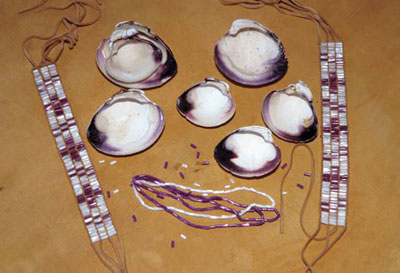Don Stott
 |
Indians were great hunters, and the Pilgrims wanted their furs and pelts to take back to England to sell at a profit, and the Indians had plenty of that, but wanted what the white man had. The Colony was supposed to show a profit for its investors, and trade was the only possible way to show one, which meant developing a system of 'money' for trade. In 1624, the Dutch trading agent Isaac de Rasiere introduced the Pilgrims to wampum, the white and purple shell beads that quickly became the medium of exchange in New England and revolutionized trade with the Indians. By the early 1630s, Plymouth had established a series of trading posts that extended all the way from the Connecticut River to Castine Maine.
Wampum consisted of strings of cylindrical beads made from either white periwinkle shells or the blue portion of quahog shells, with the purple beads being worth approximately twice as much as the white beads. To be accepted in trade, wampum had to meet scrupulous specifications, and both the Indians and the English became expert at identifying whether or not the beads had been properly cut, shaped, polished, drilled, and strung. A fathom of wampum contained about three hundred beads, which were joined to other strands to create belts that varied between one and fine inches in width. When credit became difficult to obtain from England during the depression of 1640, (there have been over a hundred 'depressions' since then), the colonies eased the financial burned in New England by using wampum as legal tender. The Indians had provided the English with what became an American way of doing business!
Wampum no longer exists as legal tender, but believe it or not, old wampum beads have become extremely collectible! Many years later, the Indians realized that wampum was merely beads, with gold and silver being the real valuables. They simply took millions of beads and discard them, threw them into the ocean, or even buried them. Today, on rare occasions, three hundred year old wampum beads can be found by beachcombers, and they are highly collectible. What all this proves, aside from a note on American history, is that what is scarce is valuable, in this case, wampum beads. There is a finite supply of Model A Fords, Tiffany lamps, gold and silver. Trees can grow, and paper money can be printed from paper made from trees, ad infinitum. As GM is now about to prove, millions of stocks can be printed, diluting the value of those already held. Banks create dollars by making loans of them, which dollars have been created out of thin air. Gold and silver do not grow on trees, nor can they be created out of thin air. People around the world are beginning to realize the self worth of gold and silver, and are buying it in ever increasing amounts. The entire world is scared, and especially of government created paper wampum. Eventually, due to their desirability and availability, gold, silver, Model A Fords, and Tiffany lamps, will continue their ascendancy in paper money prices, even though they are exactly the same Model A Fords, Tiffany Lamps, gold and silver. This is why my son and daughter, and myself deal in actual, historic, valuable, beautiful, eventually scarce, gold and silver.
Nessun commento:
Posta un commento